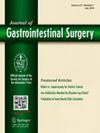Comparison of the preoperative transpapillary unilateral biliary drainage methods for the future remnant liver in patients with hilar cholangiocarcinoma with liver resection: a retrospective cross-sectional study
IF 2.2
3区 医学
Q3 GASTROENTEROLOGY & HEPATOLOGY
引用次数: 0
Abstract
Background
Transpapillary preoperative biliary drainage (PBD) only for the future remnant liver (FRL) in hilar cholangiocarcinoma (HCCA) can be performed minimally invasively, with the expectation of swelling of the FRL. However, verification of the appropriate transpapillary unilateral PBD method for FRL is limited as the cases of liver resection are insufficient.
Methods
A total of 63 patients with resectable HCCA were evaluated. Of note, 12 unilateral across-the-papilla plastic stent (PS) placement cases (PS group), 14 unilateral intraductal PS (IS) placement cases (IS group), and 11 unilateral endoscopic nasobiliary drainage cases (ENBD group) met the inclusion criteria. Each group was compared in terms of the hospital stay duration for the endoscopic procedure, recurrent biliary obstruction (RBO), time to RBO (TRBO), overall survival (OS), and surgical outcomes.
Results
No significant differences were observed in the patient characteristics between the groups. Hospital stay for the endoscopic procedure was significantly longer in the ENBD group (50 days [IQR, 33–163]) than in the PS group (14 days [IQR, 2–36]; P <.01) or IS group (21 days [IQR, 6–118]; P <.01). There were no significant differences in the RBO, TRBO, OS, surgical time, amount of intraoperative blood loss, or postsurgical adverse events (AEs) between the groups. In the multivariate analysis, there were no significantly related factors for RBO, TRBO, OS, and postsurgical AEs.
Conclusion
The PS, IS, and ENBD groups showed similar clinical outcomes in liver resection cases for HCCA, excluding the hospital stay duration for the endoscopic procedure. Considering the hospital stay duration, unilateral PS and IS placement can be considered acceptable for transpapillary PBD.

求助全文
约1分钟内获得全文
求助全文
来源期刊
CiteScore
5.50
自引率
3.10%
发文量
319
审稿时长
2 months
期刊介绍:
The Journal of Gastrointestinal Surgery is a scholarly, peer-reviewed journal that updates the surgeon on the latest developments in gastrointestinal surgery. The journal includes original articles on surgery of the digestive tract; gastrointestinal images; "How I Do It" articles, subject reviews, book reports, editorial columns, the SSAT Presidential Address, articles by a guest orator, symposia, letters, results of conferences and more. This is the official publication of the Society for Surgery of the Alimentary Tract. The journal functions as an outstanding forum for continuing education in surgery and diseases of the gastrointestinal tract.

 求助内容:
求助内容: 应助结果提醒方式:
应助结果提醒方式:


